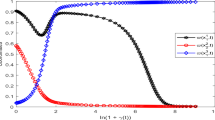Abstract
The paper proposes a Bayesian approach to selecting a particular equilibrium points * of any given finiten-person noncooperative game Γ as solution for Γ. It is assumed that each playeri starts his analysis of the game situation by assigning a subjective prior probability distributionp j to the set of all pure strategies available to each other playerj. (The prior distributionsp j used by all other playersi in assessing the likely strategy choice of any given playerj will be identical, because all these playersi will compute this prior distributionp j from the basic parameters of game Γ in the same way.) Then, the players are assumed to modify their subjective probability distributionsp j over each other's pure strategies systematically in a continuous manner until all of these probability distributions will converge, in an appropriate sense, to a specific equilibrium points * of Γ, which, then, will be accepted as solution.
A mathematical procedure, to be called thetracing procedure, is proposed to provide a mathematical representation for this intellectual process of convergent expectations. Two variants of this procedure are described. One, to be called thelinear tracing procedure, is shown to define a unique solution in “almost all” cases but not quite in all cases. The other variant, to be called thelogarithmic tracing procedure, always defines a unique solution in all possible cases. Moreover, in all cases where the linear procedure yields a unique solution at all, both procedures always yield the same solution. For any given game Γ, the solution obtained in this way heavily depends on the prior probability distributionsp 1,...,p n used as a starting point for the tracing procedure. In the last section, the results of the tracing procedure are given for a simple class of two-person variable-sum games, in numerical detail.
Similar content being viewed by others
References
Carnap, R., andR.C. Jeffrey: Inductive Logic and Probability, University of California Press, 1971.
Debreu, G.: Economies with a Finite Number of Equilibria, Econometrica,38, 387–392, 1970.
Harsanyi, J.C.: Oddness of the Number of Equilibrium Points, International Journal of Game Theory,2, 235–250, 1973.
Nash, J.F.: Noncooperative Games, Annals of Mathematics,54, 286–295, 1951.
Sard, A.: A Measure of Critical Values of Differentiable Maps, Bulletin of the Mathematical Society,48, 883–890, 1942.
Savage, L.J.: The Foundations of Statistics, John Wiley, 1954.
Author information
Authors and Affiliations
Rights and permissions
About this article
Cite this article
Harsanyi, J.C. The tracing procedure: A Bayesian approach to defining a solution forn-person noncooperative games. Int J Game Theory 4, 61–94 (1975). https://doi.org/10.1007/BF01766187
Received:
Revised:
Issue Date:
DOI: https://doi.org/10.1007/BF01766187




